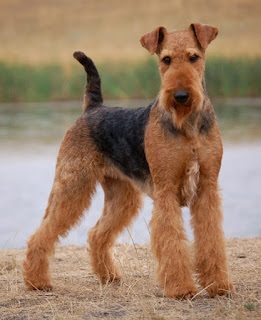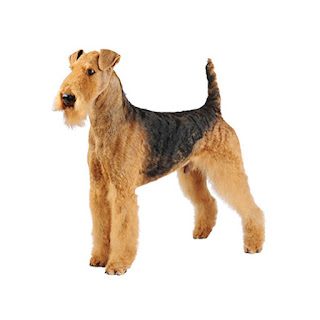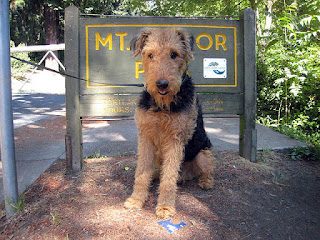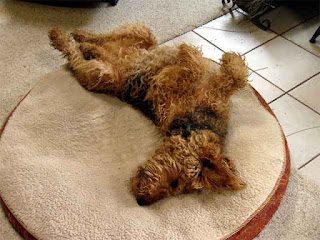Everything about your Airedale Terrier
Known as the “King of Terriers,” the Airedale is indeed the largest of all terriers. The dog breed originated in the Aire Valley of Yorkshire, and was created to catch otters and rats in the region between the Aire and Wharfe Rivers. An able sporting dog, he became an ideal working dog as well, proving his worth during World War I. Intelligent, outgoing, and confident, the Airedale possesses a wonderful playful streak that delights his owners.
Overview
Of all the terriers, there may be none that so embody what we imagine this type of dog to be than the Airedale Terrier. An authentic English terrier finds its home in a specific place – Airedale, of all places – but is just as happy to make its home with and your family. Like many terriers, you will find that this dog is capable of a lot of love, a lot of companionship, and can even make an excellent playmate. Its overall attractive coat is hard to resist for the younger members of your family and you’ll find there’s nothing quite like petting a terrier. There’s a reason, after all, they call Airedale Terriers the so-called king of terriers.
But is the Airedale Terrier for you? Depending on the type of “dog person” you are, your answer will vary. Each dog breed has its own strengths and weaknesses, and these strengths and weaknesses mean specific breeds can be more suitable to certain types of dog owners. As we learn about the Airedale Terrier, we’ll also learn about the terrier group as a whole and hopefully you’ll just find a little something out about the types of dogs you’d prefer to bring home. Let’s find out more about the Airedale Terrier.
Highlights
- Like all Terriers, Airedales have a natural inclination for digging , chasing small animals, and barking.
- The Airedale Terrier is an active collector of human memorabilia. He will pick up just about anything to add to his stash of treasures.
- Being a high-energy working dog, the Airedale Terrier needs daily exercise. In general, the he remains active and full of energy throughout his life. He is not suited to apartment life, and needs a home with a large, fenced yard.
- Chewing is another favorite Airedale habit. He will chew anything, and should be left in a crate or secure kennel with sturdy toys when you are away from home.
- The Airedale is an independent dog, but he enjoys being a member of a family. He is happiest when inside with his owners, and is not meant to be a backyard dog.
- Airedale Terriers are very good with children and are fondly called reliable babysitters. However, children and dogs should never be left unsupervised.
- Grooming is necessary, so plan on paying a professional groomer or learn to groom your Airedale yourself.
- Training and socialization is essential to teach the Airedale proper canine manners. If he is not used to other dogs and people, he can be quarrelsome.
- To get a healthy dog, never buy a puppy from an irresponsible breeder, puppy mill, or pet store. Look for a reputable breeder who tests her breeding dogs to make sure they’re free of genetic diseases that they might pass onto the puppies, and that they have sound temperaments.

- The Airedale has a long, flat skull, V-shaped ears that fold over, small dark eyes full of terrier keenness and intelligence, a black nose, and a muscular, squarish body. The tail is carried up but not over the back.
- The Airedale’s coat is hard, dense and wiry, with a softer undercoat, and comes in both tan and black and tan and grizzle.
AKC group: Terrier
UKC group: Terrier
Average lifespan: 10 to 13 years
Average size: 40 to 65 pounds
Coat appearance: Dense and Wire
Coloration: black mixed with gray and white,speckling of red in the black and a small white star on the chest
Hypoallergenic: Yes
Best Suited For: Families with older children, active singles and seniors, experienced dog handlers, houses with yards
Temperament: Protective, intelligent, loyal, sensitive
Comparable Breeds: Rat Terrier, Wire Fox Terrier
History
 |
| Airedale Terrier circa 1915 |
Airedale Terriers are a relatively young breed, created in the 19th century by the working class rather than by aristocrats in the industrial Aire River Valley region of northern England. Their exact origin is not well-documented, but the Otterhound , the Irish and Bull Terriers and the now-extinct Old English Rough Coated Black-and-Tan or Rat-Catcher Terrier are considered to be prominent in their development. Other contributors include assorted setters and retrievers, sheepdogs such as the Yorkshire Collie, and Bedlington Terriers.
What we know today as the Airedale Terrier first emerged around 1840 and was bred to hunt otter, duck, weasel, badger, fox, water rat and other small game. The breed’s intelligence, agility and strength, combined with almost boundless energy, made them equally valued as guard dogs and personal companions. These unique terriers have been used as rat-killers, duck-catchers, deer-trackers, working dogs, war dogs, hunting dogs, guard and police dogs, gun dogs, army-messenger dogs and all-around sporting dogs. They were used in both World Wars to locate the wounded and to carry messages and medical supplies. They have also been used to hunt large game.
Personality
The Airedale is a hard-working, independent, and athletic dog with a lot of drive, energy, and stamina. He is prone to digging, chasing, and barking — behaviors that come naturally to terrier breeds. These traits can be frustrating to owners unfamiliar with the Airedale personality.
The Airedale is a lively breed, and he needs plenty of activity. Don’t leave him alone for long periods of time, or he is likely to become bored, which leads to the aforementioned destructive behaviors. Keep training interesting and fresh — repetitive exercises will become a bore to the Airedale. He is best motivated by treats and other positive reinforcement methods; drill-and-jerk training methods should be avoided.
A reliable watchdog, the Airedale takes pride in protecting his family. He can be a fierce guardian, but is friendly with his family and friends.
Like every dog, the Airedale needs early socialization — exposure to many different people, sights, sounds, and experiences — when they’re young. Socialization helps ensure that your Airedale puppy grows up to be a well-rounded dog.
Health
The Airedale Terrier, which has an average lifespan of 10 to 13 years, sometimes suffers from colonic disease. Other serious health issues this breed is prone to include canine hip dysplasia (CHD), gastric torsion, and hypothyroidism. To identify some of these issues, a veterinarian may run thyroid and hip exams on the dog.
Care
The Airedale Terrier is a working dog, and has the energy and stamina that goes with it. He needs regular exercise — at least one walk a day, although two is preferable, coupled with a good romp in the backyard. The Airedale loves to retrieve, play, swim, and goof around. He is a great jogging companion, and in many cases, will tire out his owner.
Training and socialization are essential for the Airedale, beginning with puppy classes. Incorporate socialization with training by taking your Airedale with you to many different places — the pet supply store, outdoor events, long walks in busy parks. Anywhere there are a lot of people to meet and sights to see is a good place to take an Airedale.
Crate training is also strongly recommended with the Airedale Terrier. Not only does it aid in housetraining, it also provides him a safe den in which to settle down and relax. In general, Airedales do very well with most training as long as you remember that they have a mind of their own. Ask him to sit or stay in full sunlight in the middle of the summer and it’s very likely he’ll decide he’d prefer to do so in the shade.
Positive reinforcement is the best way to teach an Airedale. If you approach training with a positive, fun attitude, and you have a lot of patience and flexibility, there’s an excellent chance you will have freethinking Airedale who is also well trained.
Living Conditions
The Airedale Terrier is not recommended for apartment life. They are very active indoors and will do best with at least an average-sized yard.
Trainability
The Airedale is a thinking breed – in addition to keeping his physical activity high, he will require mental stimulation as well. Basic obedience should be conducted with confidence and positive reinforcement. This breed likes to be the Alpha Dog, so it is important to establish who is in charge from an early age, and always be consistent, because Airedales will take a mile if given an inch. They excel in advanced obedience, tricks and agility training, thanks to their high intelligence.
Training should be conducted with treats, and a drill-style of repeat tasks works best to keep an Airedale Terrier’s attention.
Exercise Requirements
Regular walking and play is recommended – and, in fact, regular discipline with exercise should be considered mandatory for dogs of this size. They can handle a lot and love getting outside and exploring their agility and instincts.
Airedale Terriers are a high-energy, thinking breed. They need as much mental activity as they need physical activity, and apartments are not the right living situation for them. Families with large, fenced yards are ideal, as the Airedale needs plenty of room to run during the day. They enjoy chasing and hunting, so fetching and hide-and-seek games are among an Airedale’s favorite activities.
Grooming
Airedales need a weekly brushing and professional grooming every two months or so to look their best. That is all they need – unless you’re planning to show your dog, in which case you’ll need to be doing a great deal more laborious work on that wiry coat.
The family Airedale doesn’t have to be trimmed, but many owners do have him groomed by a professional groomer three to four times a year to give him a neat appearance . The coat is either trimmed with clippers or by stripping, a process by which coat is thinned and shortened with a stripping knife, a sharp, comb-like tool, or a combination of both.
The Airedale Terrier is not known for extreme shedding, but he does shed certain times of the year. Regular brushing with a slicker brush once or twice a week keeps the coat in good condition. Bathe the Airedale only when he’s dirty. Bathing him too often softens the coarse terrier coat.
The rest is basic care. Trim the nails as needed, usually every few weeks. Keep the ears clean and dry to prevent infections. Check them weekly for redness or a bad odor that might indicate infection. If the ears look dirty, wipe them out with a cotton ball moistened with a mild pH-balanced cleanser recommended by your veterinarian. Brush the teeth frequently for good overall health and fresh breath.
It is important to begin grooming the Airedale when he is very young. An early introduction teaches the independent Airedale that grooming is a normal part of his life, and teaches him to patiently accept the handling and fuss of the grooming process.
Children And Other Pets
The fun-loving Airedale makes a good family pet. In some cases, he may even become protective of the children in the home, but his large size and high activity level may prove too intense for extremely young kids.
As with every breed, you should always teach children how to approach and touch dogs, and always supervise any interactions between dogs and young children to prevent any biting or ear or tail pulling on the part of either party. Teach your child never to approach any dog while he’s eating or sleeping or to try to take the dog’s food away. No dog, no matter how friendly, should ever be left unsupervised with a child.
The Airedale gets along well with other dogs in his household, as long as he is properly socialized and trained. He can be aggressive, however, with strange dogs that he perceives as threatening. And given the Airedale’s reputation as a hunter, he is very likely to chase animals he perceives as prey, including cats, rabbits, gerbils, and hamsters.
Did You Know?
The Airedale is the largest of the terrier breeds and was one of the first breeds trained for police work in Germany and Great Britain. In World War I, he worked as a guard and messenger dog.
Is the Airedale Terrier the Right Breed for you?
High Maintenance: Grooming should be performed often to keep the dog’s coat in good shape. Professional trimming or stripping needed.
Minimal Shedding: Recommended for owners who do not want to deal with hair in their cars and homes.
Moderately Easy Training: The Airedale Terrier is average when it comes to training. Results will come gradually.
Fairly Active: It will need regular exercise to maintain its fitness. Trips to the dog park are a great idea.
Not Good for New Owners: This breed is best for those who have previous experience with dog ownership.
Good with Kids: This is a suitable breed for kids and is known to be playful, energetic, and affectionate around them.
Notable Airedales
 |
| The memorial fountain for Paddy the Wanderer, Wellington |
- Laddie Boy– (July 26, 1920 – January 23, 1929) was an Airedale Terrier owned by US President Warren G. Harding. He was born in Toledo, Ohio. His father was Champion Tintern Tip Top. He was presented to US President Warren G. Harding by Charles Quetschke of Caswell Kennels and became a celebrity during the Harding administration.
- Paddy the Wanderer- was an Airedale Terrier who roamed the streets of Wellington, New Zealand, during the Great Depression. He was a friend of cabbies, workers, and seamen alike, who took turns at paying his dog licence every year.Paddy was known for greeting sailors in the Wellington Harbour and accompanying them, as a stowaway,on their coastal steamers.







